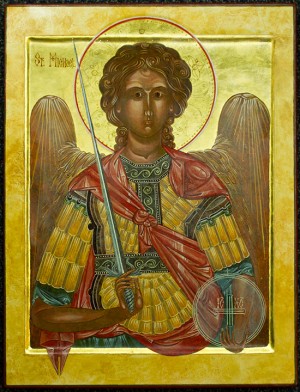

By Rebecca Fiedler
Reporter
Carol Perry is a Baylor lecturer who does things a little differently.
Perry is a full-time lecturer in journalism, public relations and new media. When she’s not performing her instructional duties, however, she’s connecting with God in a way that many Christians have never even heard of: she’s writing icons.
Iconography is a symbolic style of religious painting, though the creation of an icon is typically referred to as “writing,” not “painting.” Perry said she creates icons through 15th century Russian methodology. Perry majored in art when she was a college student at Texas Christian University and gained an interest in Byzantine art. Her paintings are usually of Christ, the virgin Mary, John the Baptist or one of many saints.
The Rt. Rev. Jeff Fisher, a bishop in the Episcopal Diocese of Texas and former director of St. Alban’s Episcopal Church in Waco, knows Perry through his time spent serving at St. Alban’s, where Perry attends.
“Making an icon is not like painting,” Fisher said. “It’s a spiritual practice where every layer in the making of an icon leads you down a spiritual journey. That’s how Carol experiences it.”
Making an icon is a long process that begins with a layer of gold, Fisher said. People will request Perry to make an icon for them, he said. Perry will talk to them to learn details about their spirituality, praying about that person as she creates the icon, Fisher said.
“We are not trying to interpret what was done,” Perry said of iconographers. “We are trying to honor the tradition and be true to the tradition. Even the process of making the paint – we make our paint the same way they made their paint in the early medieval days. And that’s to honor the tradition they did.”

Curtis Callaway | Lecturer in journalism, public relations and new media
The process of making icons is divided into three different levels, Perry said. The key is going from darkness to light, she said. The first level of painting involves natural light, which represents light before humanity existed. The second level is concerned with man’s light or human understanding. The last level represents spiritual progression toward God’s light, which is what the gold leaf symbolizes.
“It’s a prayerful process,” Perry said. “Sometimes you’re consciously praying as you’re working, and that’s part of the gift to those of us who do the work; the tremendous peace that comes with the work.”
Icons are written with paints made from all natural materials, Perry said.
She makes her own paint, and the ingredients come from all over the world. She gets azurite, a blue shade from Afghanistan. One kind of yellow, called ‘Indian Yellow,’ is made from camel urine. One color of paint even uses mercury.
Iconography, however, is not only a spiritual practice for the creators of it but also for those who enjoy looking at it.
Dr. Blaine McCormick, associate professor in the Hankamer School of Business, has commissioned icons from Perry.
One of those icons, an image of Christ, sits in his office by his computer screen. He calls this his “traveling icon” and has taken it with him to Africa and Central America. McCormick uses this painting for personal devotional practice, he said.
“Moving pictures have come to dominate our lives,” McCormick said. “You see that icon? It never moves. It’s an oasis of quiet there, right by my computer screen, and that icon teaches me every day. It never moves, and it teaches me consistently, and this is due to Carol’s good work.”
McCormick said to work with an icon means to look at it and use it to focus one’s thinking. It’s not about clearing the mind, though – it’s filling the mind with the correct things, he said.
“It’s not like magic,” Fisher said. “It’s just a tool – some people get on their knees to pray, some close their eyes, some say the same phrase over and over again – it’s just a tool that people use to get their mind off of themselves and put their minds onto God.”
Fisher said he sees icon usage as a form of sacrament. What a sacrament means, he explained, is that God speaks to people through material things, such as through bread, wine or the water in baptism.
“Icons allow you to have a different kind of partner in prayer – a different tool, no different than a prayer book,” McCormick said. “And, in its deepest essence, an icon should be a window to heaven.”
McCormick said Perry’s icons have special meaning to him as opposed to a generic printed icon because he knows Perry, who prayed specifically for him while she wrote his icon.
“It’s a real gift to me,” Perry said of icon writing. “It’s the perfect marriage of art and faith.”





